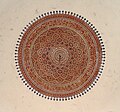Isa Khan Niazi
Isa Khan Niazi ( Pashtun عیسی خان نيازي; * 1453 ; † 1548 in Delhi , India ) was a Pashtun nobleman at the court of Sher Shah Suri and his son Islam Shah Suri from the Sur dynasty , which ruled India in the 16th century and fought the Mughal Empire .
Links to ruling dynasties
The period from 1451 to 1525 was the golden period of the Pashtun rulers of the Lodi dynasty , who ruled large parts of the Indian subcontinent at the time. From 1526 to 1540 they were ousted by the Mughals, but with the Suri dynasty from 1540 to 1555 they were able to regain power, at least for a short time. Isa Khan Niazi was a prominent member of the ruling family that made up the Lodi Dynasties and the Suri Dynasties. He came from the same tribal group as the rulers Ibrahim Lodi and Sher Shah Suri (see also List of Sultans of Delhi ). Isa Khan died in Delhi in 1548 at the age of 95.
Isa Khan's tomb
Isa Khan's tomb was erected during his lifetime (around 1547 to 1548). It is located near the place where the tomb complex of the Mughal emperor Humayun in Delhi was later to be built from 1562 to 1571 . The octagonal tomb of Isa Khan has special decorations in the form of canopies , glazed tiles and lattice windows ( jali (architecture) ) as well as a deep porch supported by columns. Today it stands south of the Bu Halima Garden at the entrance to the Humayun complex. An inscription on a red sandstone slab indicates that the tomb is that of Masnad Ali Isa Khan, son of Supreme Chamberlain Umar Khan, and that it was during the reign of Islam Shah Suri, son of Sher Shah in 1547 until 1548 was built.
Extensive restoration work on this grave led to the discovery of the oldest sunken garden in India on August 5, 2011. This concept was later developed further in the Akbar Mausoleum and the Taj Mahal .
Jali window
Isa Khan Mosque
On the edge of the complex, opposite the tomb, is the Isa Khan mosque with important mihrabs . It was erected at the same time as the tomb. Many of the architectural details present in these structures (such as the tomb housed in a walled garden) can be seen in a larger dimension in the Humayun Tomb.
ancestry
Isa Khan belonged to the Pashtun tribe of the Niazi. His descendants still live in the western border region of Pakistan , mainly in Isa Khel in the Mianwali district. The city of Isa Khel was founded around 1830 by Ahmad Khan, the ancestor of today's khans of Isa Khel, and takes its name from Isa Khan.
Web links
literature
- Ram Nath: History of Mughal Architecture, Volume I. New Delhi: Abhinav Publications, 1985, p. 235
- Giles Henry Rupert Tillotson: Mughal India. San Francisco: Chronicle Books, 1990, pp. 40-41, 48
| personal data | |
|---|---|
| SURNAME | Niazi, Isa Khan |
| ALTERNATIVE NAMES | عیسی خان نيازي & lrm (psS) |
| BRIEF DESCRIPTION | Pashtun nobleman at the court of Sher Shah Suri and his son Islam Shah Suri from the Sur dynasty |
| DATE OF BIRTH | 1453 |
| DATE OF DEATH | 1548 |
| Place of death | Delhi , India |









